While the devout meditate upon the Second Coming of Christ or the Tenth Avatar of Vishnu, Buddhists create exquisite art to welcome the Buddha of the Future.
LOOKING FOR BUDDHA IN THE DETAILS
by
Shubha Priya
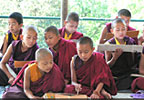
(click on the photos to enlarge them - then tap
the 'back' button to return to this page)
Monastic life. You'd think it is about solitude, contemplation and prayer. Then how come the art of the Gompas (monasteries) in the Himalayas celebrate the sensual and the sublime in such a riot of color?
I think I understand. It has to do with going back to childhood. Blue, red and yellow got my attention as a kid. Messing with paint, I discovered endless color combinations and possibilities. Every picture book story I can recall was vividly alive. Even stories verbalized by family elders brought color into imaginative play. It sure made remembering easy.
I believe the Buddhist monks have held on to that childlike innocence, even as they seek the spiritual and profound. They tell their stories in color and pictures to make learning easy.
I am on an unplanned holiday from Calcutta, on a side trip to Darjeeling and Sikkim, when I become a self-styled student, exploring the art of the Gompas. The colors just happen to leap out of the walls without warning, and as a naive but fascinated beginner, I have no prior research to help me understand it all better. Fresh eyes, I hope, will bring fresh insights.
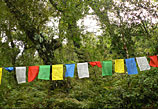 |
|---|
The first thing that strikes me are the ubiquitous, fluttering prayer flags, dotting the mountain scape. Blue, white, red, green and yellow. I learn from a local school teacher in Gangtok, hitching a ride back home, that they stand for sky, air, fire, water and earth. Each has a prayer that produces a 'spiritual vibration' activated and carried by the wind to protect people from diseases and natural disasters. These are blessings spread on the 'breath of nature'.
Between visiting the oldest Gompa, the Sangachoeling (Palace of Secret Spells) built in 1697, and the newer, more famous, rebuilt Rumtek monastery of 1960, I begin my search for god in the exquisite details.
A steep, precipitous climb uphill, while on the lookout for leeches that my Lonely Planet guide warned me about, gets me to the Sangachoeling Gompa. I reach the summit, completely out of breath. And what I see there takes my breath away some more.
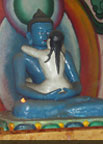 |
|---|
It is a sculpture of the Buddha with a seductive nude strapped to his waist.
At first, it seems the Buddha is being tested to overcome some “Last Temptation”. But hold on, this is Buddhist symbolism - surely it cannot be taken literally. A monk notices my stupefaction and smiles. This is, he explains, yab-yum (literally, father-mother), the ntegration of the instinctive with the exalted, the pairing of opposites as the highest realization. Something clicks. I have a fleeting insight into the nature of duality. Is this a tiny step in my path towards enlightenment?
 |
|---|
The Gompas are resplendent with many avatars of Buddha. But I didn’t expect to see the yet-to-ppear Maitreya Buddha with deep blue eyes, gaze upon me at the Yogachoeling Gompa in Darjeeling. The belief is that this coming spiritual leader will one day be born in the west. This to me seems truly transcendental!
But the immediate challenge is to transcend
my physical self and get my body down a mountain – to see the Bhutia
Busti Gompa. because my Lonely Planet tells me
it has a version of the original Tibetan Book
of the Dead manuscript. How can I miss that! I once read the transcript
in English and I was fascinated.
So with thudding heart and parched lips, I descend.
But make the mistake of looking up, midway. My will gives up. I cannot
see myself climbing up all the way back again. Impossible!
As I gaze on the monastery, so close, yet so
far, I have personal revelation: the path to enlightenment is hindered
greatly if the flesh is, uh…weak.
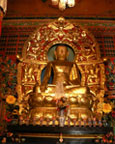 |
|---|
But
at least I can feast my eyes on other hidden
treasures to discover off the not-so-challenging paths. Like the lesser
Lindum monastery with its bright, gorgeous, golden Buddha. It is breathtaking,
but also somewhat gaudy and commercial in its appeal. And if one
is looking for a sensory overload, there is the
stunning Rumtek monastery, the most famous of all in Sikkim, Walls ablaze
with color and detail and the monks, so eager to explain it all. There
are treasures and icons, intricate woodwork and paintings. I need to
rest my eyes and simply gaze at the stark white Himalayas yonder for
while!
The
Pemayangtse (Perfect, Sublime Lotus) Gompa is
set against the backdrop of the magnificent KanchenZonga,
the world’s third highest peak.
I am thinking, this is as close to heaven as
one can get, when a delightful grin breaks out on the wrinkled face of
a monk as he opens the door, to show me a view of paradise on the top
floor of the Gompa! It is a massive 7-tiered wooden sculpture depicting
Guru Padmasambhava’s
Heavenly Palace - ‘Zandogpalri’. This masterpiece created
single-handedly by the late Dungzin Rimpoche
took five years to complete. One can feel the
intense, focused devotion. Rainbows, angels and saints grace the hallowed
atmosphere. It is awesome and to me, naive, at the same time.
One symbol pops up everywhere. The Wheel of Life image that tells the whole tale of life on Earth in one graphic, symbolic snapshot! The ceaseless striving of beings, in the clutches of a monster, epitomizing our passionate attachment to material desires. And there is the stuff of drama too - lust, anger, ignorance - all root causes of our suffering. The Never Ending Story of Good versus Evil is depicted here, accompanied by a hint of… nirvana. The teaching is simultaneously childlike and complex.
Before long, I began to see art in everything. In the way fresh marigolds growing in profusion, mimic the colors of the Buddhist monks' habits. In the chocolate and vanilla ice-cream cone that replicates a peakin the KanchenZonga range.
Now every tale I hear, takes a shape on the walls of my imagination. I am told a Buddhist Llama in Lachung has the power, at the request of the locals, to 'tie up the snow' and prevent bad weather from affecting mountainfolk.
I picture a serene Buddha on a lotus. In his hand: a blazing white Himalayan snow peak, tied with a subtle black thread. He is restraining a massive avalanche, while mountainfolk go about praying or being busy.
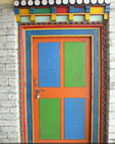 |
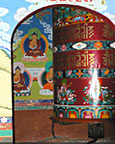 |
 |
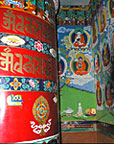 |
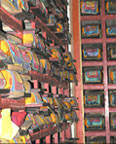 |
|---|
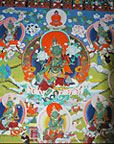 |
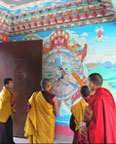 |
|---|